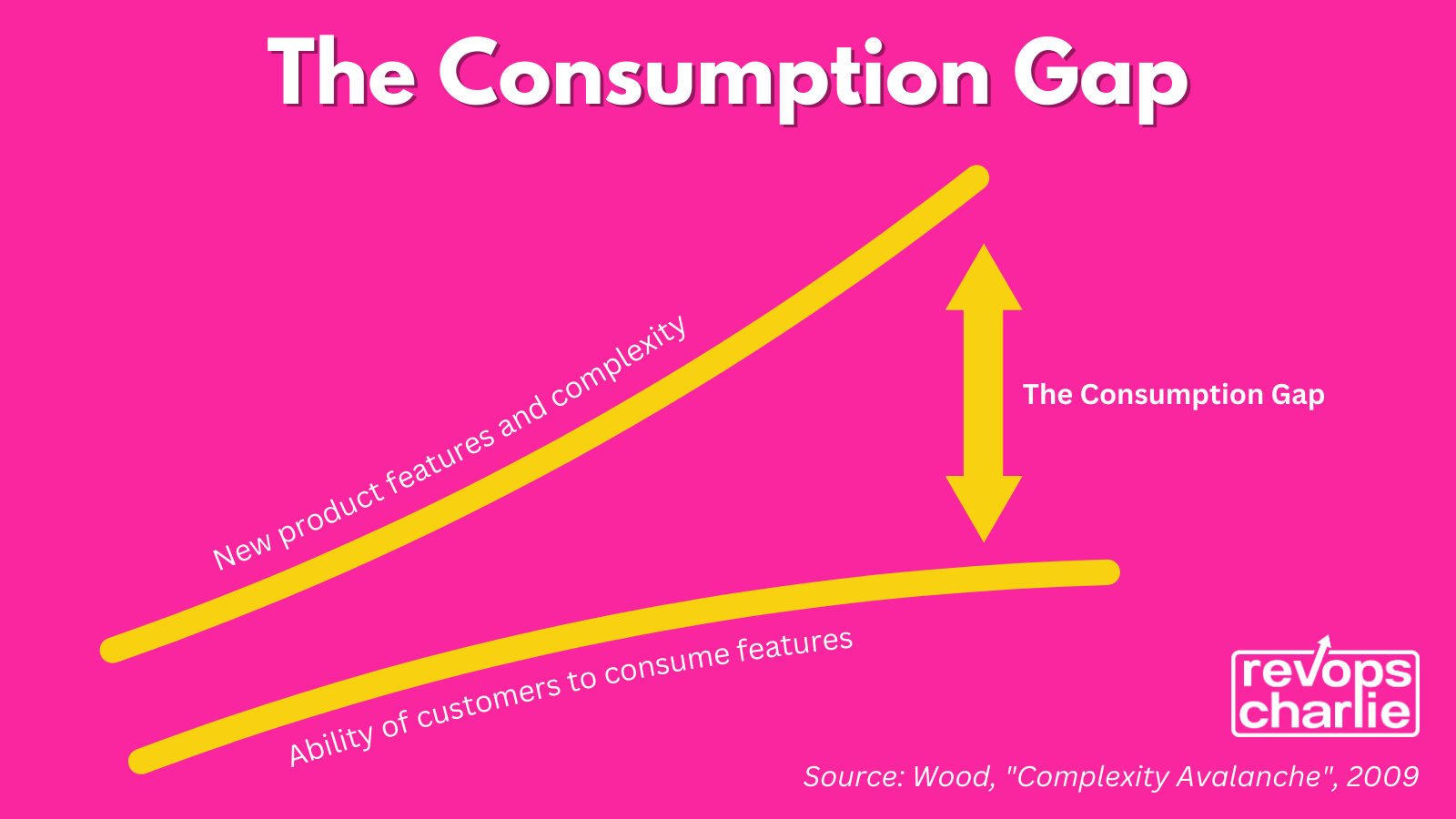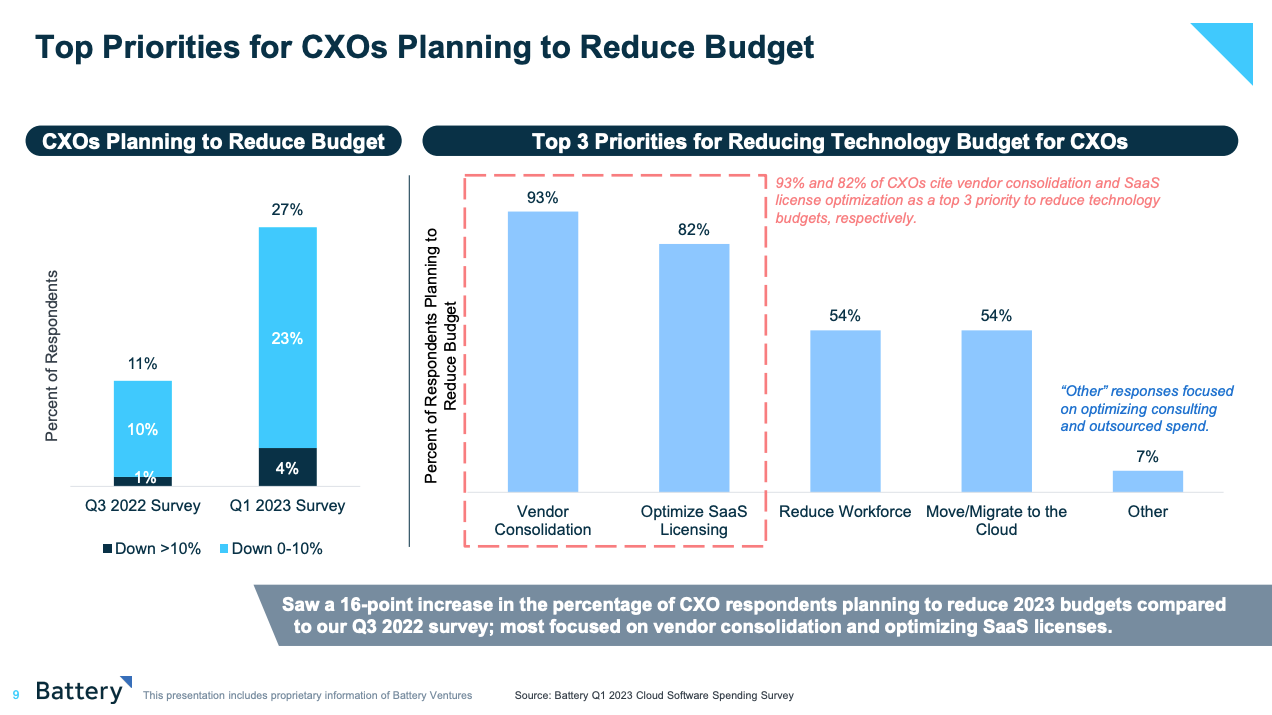Reducing the consumption gap with CSMs
SaaS businesses can grow ARR in two ways:
Bring more customers in through the front door
Sell more to the customers they already have
And that second approach is where so much firm value exists.
As a company can you:
Launch (or acquire) new products that you can sell to your customers
Launch new features that help your customers get more value from your products
Help your customers use these new products and features
As a result minimise the churn from customers who don’t see value.
A graphic that I love is The Consumption Gap, first described by J.B.Wood in his book Complexity Avalanche from 2009.
He describes how with the introduction of SaaS in the early 2000s and the move to quarterly, monthly, or even weekly product releases, the ability for a customer to keep up with everything being delivered to them is outstripped by the functionality vendors deliver.
And if customers don’t use your new products or features then not only is it a waste, but they actually see it as a negative - they are paying for features they don’t need.
“If your end customers can’t figure out how to use your product or they can’t get it to work in their network or they can’t change their business process to adapt to its features, it has little or no value to them.”
The role of the CSM is to try and minimise this consumption gap for your customers and it is split across three dimensions
Core product that was purchased
Your customer bought one of your products to solve a need. They went through their buying process, had the joy of working with your sales, legal and onboarding teams and now have the required access to the product they wanted.
Your CSMs role is to ensure they get value from the product they bought:
Does your CSM have a clear understanding of the problem the customer was trying to solve?
Are the customer’s admin users enabled on the full capability of the product?
Are the end users enabled on the full capability of the product?
Do you have a mutually agreed plan for driving and measuring adoption?
Do you have regular scheduled meetings to review progress with executives?
There should be zero consumption gap here.
The customer bought a product to solve a problem - there is no excuse for the onboarding and CSM team not delivering on that promise to the customer.
Additional features to the core product
SaaS businesses continually roll out new features. Some may be minor tweaks and bug fixes, and some may be larger modules solving new use cases.
Typically SaaS companies will bundle these features up into a quarterly release to make it easier to market and enable customers on.
A common trap for CSMs here is to focus straight in on the product features instead of the problem the feature solves:
“We just launched XXXXX, let me show you how it works.”
Sales teams know that focusing on the features is a fast track to nowhere - they know that customers need to understand the problem first, and appreciate the impact of that problem on their business before they can start thinking about a solution.
CSMs are salespeople - they aren’t selling these new features for money, but they are asking for time, a change in processes, new integrations, training, or a launch event.
Your CSMs can help reduce the consumption gap for new features by:
Developing questioning around the problem the feature solves
Working with sales or enablement teams to develop the right content
Understanding who the economic ‘buyer’ of the new feature would be
Understanding how the customer solves this problem today
Developing a mutual business case with the customer for solving that problem
These ‘free’ additional features are a common area for the consumption gap to take hold.
Its not enough to say “here’s some new product - when are you going to turn it on?”
Upsold products
The third category are new products that the customer is paying for, and they fall into two sub-categories themselves:
An upsold product the customer specifically licenced (ie. a new module or a new product from an acquired business)
A bundled product as part of a platform deal
In the second example - imagine your customer has moved from your “Premium" package to your “Enterprise” package and as a result now has access to all your products.
They didn’t specifically order those new products, but they have them now, they are paying for them, and they know it!
With upsold products it is tempting for your CSMs to short circuit some of the groundwork they did when the new customer came on board:
Understanding the problem the customer wanted to solve
Mapping out the leadership, admins and super users
Defining a plan for admin and user adoption
Scheduling in regular executive checkins
Upsold products are likely to have a different set of stakeholders, metrics and reporting, but the temptation is to build of your core product’s CSM cadence.
This third category is where we see the consumption gap grow further - as the gap between the value the product could provide and what value the customer does receive gets progressively larger.
The Consumption Gap is more important than ever
In Battery Ventures Q1 2023 Cloud Software Spending Survey the top two priorities for CXOs to reduce technology spend were:
Vendor consolidation
Optimising SaaS licensing
If you have customers who see a consumption gap then you are in the firing line.
Your customer is thinking:
Can we get rid of this vendor completely and use others in our stack?
Can we remove modules or users and reduce our spend with this vendor?
Can we negotiate a reduced fee because of our low adoption?
If you have no/low consumption gap this makes it much harder for your customer to argue.
Get started
Whenever you are ready, there are two ways that I can help you accelerate your revenue growth.
Buyer Experience Audit - I’ll impersonate a buyer researching your segment and company and let you know what I find. Ideal for planning your RevOps strategy.
RevOps Impact Playbooks - I’ll help you implement one or more tactical processes across your revenue teams - content, referrals, testimonials, adoption and more.


